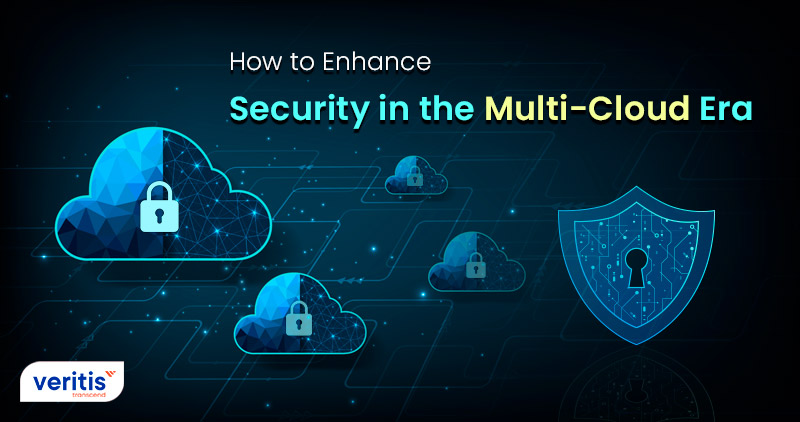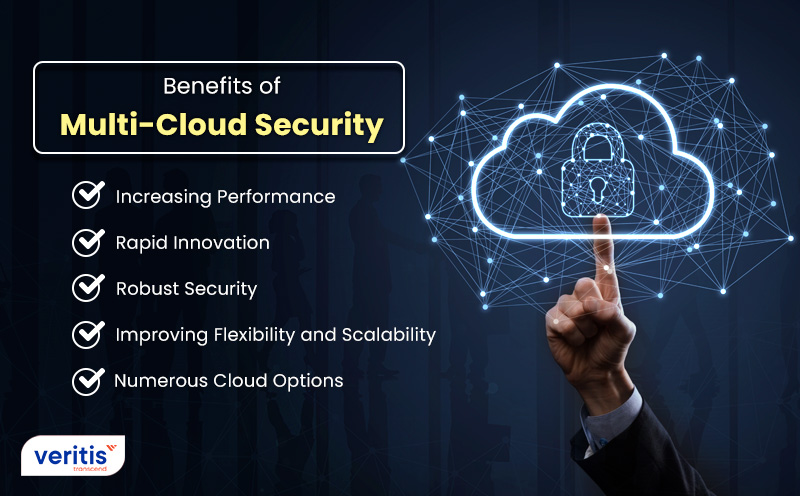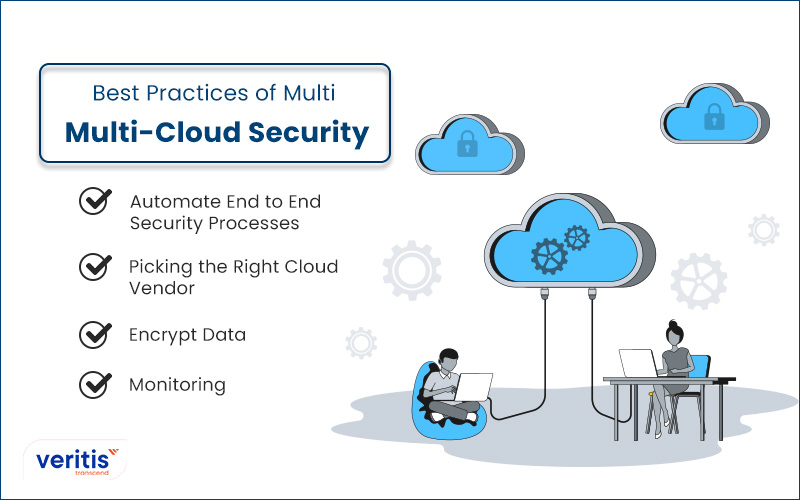How to Enhance Security in the Multi-Cloud Era

Over the past two decades, companies would use a single public cloud service provider to handle all of their digital infrastructure needs. Recently, most cutting-edge companies have relied on multi-cloud platforms as they are essential to reach high availability. There are three options for mission-critical systems – multi cloud, hybrid cloud, or hybrid multi cloud.
“According to Dynatrace report, 89 percent of IT firms said that it is hard to protect multi-cloud systems due to the increasing use of containers and Kubernetes. Therefore, it is obvious that companies must develop a thorough and efficient multi-cloud security plan.”
Infrastructure as a Service (IaaS) platforms use a multi-cloud strategy for many public clouds. In this process, the operational methods and applications that work consistently across multiple domains are abstracted from the variations in cloud providers. As a result, a multi-cloud plan allows companies to use workloads across various cloud platforms, including public and private clouds.
Companies often use multiple cloud service providers so that each client can access the features they need at a different price point that fits their budget. In addition, it provides companies more chances to use the benefits the cloud offers. This blog post will guide you in understanding the concept of multi-cloud security, its benefits, impediments, and best practices.
Schedule A Call With Our Cloud Consultant
What is Multi-Cloud Security?

Multi-cloud security is a cybersecurity model that guides companies to protect their applications, data, and other virtualized assets spread over their conditions. Unfortunately, multiple cloud environments are hard enough to handle, and IT teams must manage a wide range of tools, systems, and methods to ensure security throughout their cloud infrastructure.
Multi cloud security architecture is a set of solutions, techniques, and methods a company relies on to ensure safety in multiple cloud conditions. With this level of security, a company can take advantage of multi-cloud without exposing its assets and data to threat actors.
Numerous cloud service providers with regulations and features complicate cloud security tasks that include:
- Providing uniform security measures
- Creating a solid access control system
- Detect vulnerabilities
- Keeping a comprehensive perspective on security
Cloud service providers are typically responsible for maintaining the security of their clouds, while clients are responsible for maintaining security within their clouds.
Cloud vendors have to follow a few procedures, and they are:
- Make sure the cloud infrastructure is reliable, secure, and up to date
- Protect data centers and hosts
- Offer customer tools for data protection, such as access management software and encryption tools
The company that deploys a multiple cloud strategy is responsible for how the group maintains and uses data in each cloud infrastructure.
The internal team in a company must follow:
- Create a plan for cloud disaster recovery
- Create the system architecture for security
- Configure data loss prevention (DLP)
- Make sure that all necessary laws and regulations are followed during operations
- Update third-party tools if necessary
- Create privileges and access rules
- Design secure deployment techniques
- Cloud monitoring management
- Detection and handling of security incidents
- Create backups
Useful link: Multi-cloud, the Future of Enterprise Cloud Computing
Benefits of Multi-Cloud Security

Increasing Performance
A multi-cloud approach enables businesses to build a fast infrastructure that maximizes application performance while lowering the cost of combining cloud solutions with their current IT infrastructure. Companies can build connections that enhance response times and user experience by expanding networks to various cloud providers. In addition, multi-cloud enables companies to pick their preferred cloud service providers, thereby increasing their performance.
Rapid Innovation
One of the critical advantages of that multi-cloud plan is the ability to grow and innovate quickly. In addition, you can focus more on innovation and decide how your company develops because you are not restricted to a specific cloud provider.
Robust Security
Cloud service providers are accountable for the security of their infrastructures and can ensure that your company has all the tools required to protect your data. Make sure you fully comprehend how each entity in your cloud environment interacts with the available cloud applications. Because your architecture and software are constantly evolving, you must regularly evaluate the security of your network.
Improving Flexibility and Scalability
With data volume growing exponentially, multi-cloud architecture is the best option for companies to store and analyze their data. In addition, it provides companies the flexibility to scale up and down their storage needs.
Numerous Cloud Options
Distributing your data across several clouds enables you to opt for different cloud service providers depending on how well their advantages complement different aspects of your company.
Useful link: Multi-Cloud Environments Alter Firms’ Cloud Strategies
Impediments to Multi-Cloud Security
While many roadblocks exist in the multi-cloud environment, some of the most frequent ones include the lack of speed, poor visibility, data unpredictability, lack of consistency, and the development of advanced cybercrimes.
Lack of Visibility
Third-party service providers handle cloud security and typically employ a unique approach. Unfortunately, that not only complicates the security plans even more for your internal security team, and they lose insight into some of your cloud infrastructures.
Data Governance
Multi cloud systems are most advantageous when employees can access and share data across many clouds. However, this level of data sharing can be very high. If you do not have the protocols and procedures in place for data governance, your data might be at risk.
Unpredictability
Scalability is the main advantage of a cloud based infrastructure. Resources can be added indefinitely to handle workload processing demands and reroute data to satisfy user requests. Although data can change in unanticipated ways, one of the drawbacks of this kind of transformation is that no security team wants to manage it.
Useful link: Google’s Anthos: The Hybrid and Multi-Cloud Platform That You Need
Best Practices of Multi-Cloud Security

Automate End to End Security Processes
One of the best ways to improve multi-cloud security is to automate your complete security process. This increases the significance of your threat detection and incident response methods while reducing costly errors. To maximize automation, find the repetitive, manual operations that can reduce, so your security teams can focus on response and threat analysis.
Picking the Right Cloud Vendor
Security starts with picking the right cloud service provider. Selecting the right cloud platform can reduce security concerns because every cloud service is architected differently. AWS, Azure, and GCP are the most reliable and secure cloud providers in the current era. The top three cloud services, AWS, Azure, and GCP, allowing MSPs to build and manage resources of any size effectively. As a result, companies can depend on these cloud providers to build secure workloads and robust infrastructure.
Encrypt Data
Data encryption is one of the multi cloud security best practices. Cloud-encrypted data is safe and challenging to compromise unless it is decrypted. It’s the best option to encrypt data at rest and in transit while running a cloud-based MSP. Data that has been encrypted and can’t be read it. Due to data’s unreadability and lack of utility, hackers can’t access it even in a data breach.
Monitoring
One of the best multi-cloud security plans is constantly monitoring your cloud environment. It is vital to automate monitoring across all cloud environments to stay ahead of any security issues. You can identify problems in your cloud and address them immediately with real-time monitoring.
Conclusion
There are always new security challenges when we are heading towards a multi cloud computing. However, there are enough advantages that companies have already implemented multi clouds. Therefore, understanding the business drivers that led to the multi-cloud decision is an essential choice for an enterprise.
A robust security solution is required for dynamic cloud environments. But opting for the right cloud security solution for your multi-cloud setup can be tough. Check each multi cloud security solution carefully and gather all the necessary information such as better pricing, specific features, achieving data sovereignty, etc.
Implementing multiple cloud approach is not a big task; what matters is making it successful. This is where the Stevie Awards Winner Veritis comes in place. Veritis has high-touch security experts that offer multiple tools to protect your application and data deployed in multi-cloud environments. So, reach out to us and have a robust security solution for your enterprise.
Enhance Cloud Security Services Got Questions? Schedule A Call
Additional Resources: